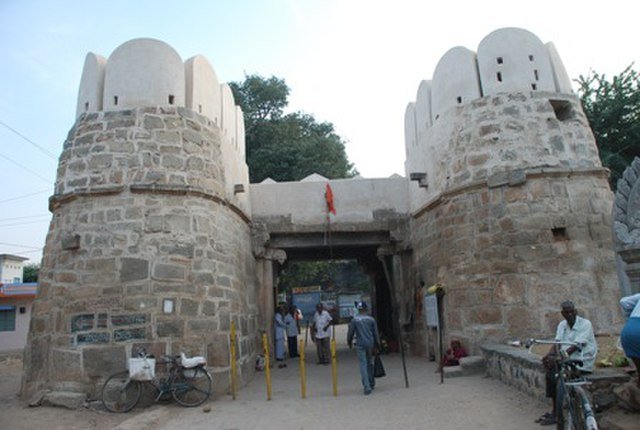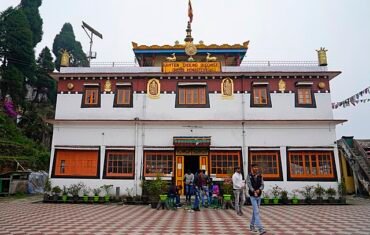Overview
Thimmamma Marrimanu, located in the Anantapur district of Andhra Pradesh, India, is a marvel of nature and an awe-inspiring symbol of life’s resilience. This site is home to the world’s largest banyan tree, covering an area of over 5 acres. The banyan tree is not just a natural wonder but also holds significant cultural and spiritual importance for the locals. The tree is named after Thimmamma, a devoted wife who committed Sati (self-immolation) after the death of her husband, and a small shrine dedicated to her is situated beneath the tree’s vast canopy. Mahabalipuram One day Trip
Declared the largest tree specimen in the world by the Guinness Book of World Records in 1989, Thimmamma Marrimanu is a popular pilgrimage site and a natural attraction for visitors. The tree’s branches extend over acres of land, creating a sprawling canopy that provides shelter to numerous birds and small animals. The tree is a symbol of endurance and continuity, representing the eternal cycle of life.
Read More : Discover the Sri Ranganayaka Swami Temple in Kurnool: A Complete Guide
Location of Thimmamma Marrimanu

- State: Andhra Pradesh, India
- District: Anantapur
- Village: Gootibayalu
- Address: Thimmamma Marrimanu, Gootibayalu Village, Kadiri Mandal, Anantapur District, Andhra Pradesh, 515551
- Coordinates: 14.0165° N, 78.3176° E
Thimmamma Marrimanu is located near the small village of Gootibayalu in the Kadiri Mandal of Anantapur district. It is about 35 kilometers from the town of Kadiri and approximately 100 kilometers from the district headquarters, Anantapur.
Time/Entry Fees of Thimmamma Marrimanu

Visiting Hours
Thimmamma Marrimanu is open to visitors throughout the year. The best time to visit is during the early morning or late afternoon when the weather is pleasant, and the sunlight filtering through the tree’s massive canopy creates a mesmerizing sight.
- Visiting Hours: 6:00 AM to 6:00 PM
Entry Fees
- Entry Fee: Free
There is no entry fee to visit Thimmamma Marrimanu. The site is open to all, offering a unique experience of walking under one of the largest living organisms on Earth without any charge.
How to Reach Thimmamma Marrimanu

By Air
The nearest airport to Thimmamma Marrimanu is Kempegowda International Airport in Bangalore, Karnataka, which is about 160 kilometers away. The airport is well-connected to major cities across India and international destinations. From the airport, visitors can hire a taxi or use app-based cab services to reach Thimmamma Marrimanu, with the journey taking around 3 to 4 hours by road.
By Rail
The nearest railway station to Thimmamma Marrimanu is Kadiri Railway Station, approximately 35 kilometers away. Kadiri is well-connected to major cities like Bangalore, Hyderabad, and Tirupati. From Kadiri Railway Station, visitors can hire a taxi or take a local bus to reach Thimmamma Marrimanu. The road journey from Kadiri to Thimmamma Marrimanu takes about 45 minutes.
By Road
Thimmamma Marrimanu is well-connected by road, with regular bus services from nearby towns such as Kadiri and Anantapur. Visitors traveling from Bangalore can take the NH 44 and NH 42 routes, while those coming from Hyderabad can travel via NH 44. The site is accessible by car, with ample parking available for visitors. Local transportation options, including taxis and auto-rickshaws, are also available for the short journey from nearby towns.
Things to Do at Thimmamma Marrimanu

1. Explore the Vast Canopy
The primary attraction at Thimmamma Marrimanu is, of course, the massive banyan tree itself. Visitors can spend hours walking beneath its sprawling canopy, which covers an area of over 5 acres. The experience of being surrounded by this living giant is both humbling and awe-inspiring. The tree’s numerous aerial roots descend from the branches to the ground, forming new trunks and creating a labyrinth of interconnected growths.
2. Visit the Thimmamma Temple
Beneath the vast canopy of the banyan tree lies a small temple dedicated to Thimmamma, the woman after whom the tree is named. The temple is a place of worship for the locals, who believe that Thimmamma has divine powers and that her spirit resides in the tree. Visitors can offer prayers at the temple and learn about the legend of Thimmamma, which adds a spiritual dimension to the visit.
3. Picnic Under the Tree
Thimmamma Marrimanu’s serene environment makes it an ideal spot for a picnic. Visitors can bring food and spend a leisurely day under the shade of the banyan tree, enjoying the tranquility and natural beauty of the surroundings. The site is also a great place for birdwatching, as the tree attracts a variety of bird species.
4. Photography
The sheer size and grandeur of Thimmamma Marrimanu make it a photographer’s paradise. The tree’s extensive network of branches and roots, combined with the natural light filtering through the leaves, creates endless opportunities for capturing stunning photographs. Whether you are a professional photographer or just someone who enjoys taking pictures, Thimmamma Marrimanu offers a unique and beautiful setting.
5. Explore the Surrounding Area
The area around Thimmamma Marrimanu is rural and largely unspoiled, offering visitors a glimpse into the local lifestyle. You can explore nearby villages, interact with the locals, and learn about the traditional practices and customs of the region. The simplicity and charm of the surrounding countryside add to the overall experience of visiting Thimmamma Marrimanu.
Nearest Tourist Attractions of Thimmamma Marrimanu
Exploring Penukonda Fort: Best Historic Gem in Andhra Pradesh
Overview Penukonda Fort, an impressive historical fortress located in Andhra Pradesh, stands as a testament…
Thimmamma Marrimanu: The World’s Largest Banyan Tree and Its Fascinating Legacy
Overview Thimmamma Marrimanu, located in the Anantapur district of Andhra Pradesh, India, is a marvel…
Gooty Fort: A Majestic Relic of Andhra Pradesh’s Rich History
Overview Perched majestically on a hilltop in the Anantapur district of Andhra Pradesh, Gooty Fort…
1. Lepakshi Temple
Lepakshi Temple, located about 120 kilometers from Thimmamma Marrimanu, is a significant architectural and religious site dedicated to Lord Veerabhadra. The temple is known for its exquisite carvings, murals, and the famous hanging pillar. The temple’s large Nandi statue, which is one of the largest in India, is another major attraction.
2. Kadiri Lakshmi Narasimha Swamy Temple
The Kadiri Lakshmi Narasimha Swamy Temple, located 35 kilometers from Thimmamma Marrimanu, is a prominent Hindu temple dedicated to Lord Narasimha, an avatar of Vishnu. The temple is known for its ancient architecture, intricate carvings, and spiritual significance. It is a popular pilgrimage site and is especially crowded during festivals like Narasimha Jayanti.
3. Belum Caves
Belum Caves, situated approximately 90 kilometers from Thimmamma Marrimanu, is the second-longest cave system in India. These naturally formed limestone caves are known for their stunning stalactite and stalagmite formations. Visitors can explore the various chambers of the caves, including the Meditation Hall and the Banyan Tree Hall, making it an adventurous and educational excursion.
4. Anantapur Clock Tower
Anantapur Clock Tower, located about 100 kilometers from Thimmamma Marrimanu, is a historical landmark in the heart of Anantapur town. Built during the British era, the clock tower stands as a reminder of the town’s colonial past. It is surrounded by a bustling market area, where visitors can shop for local handicrafts and enjoy the vibrant atmosphere.
5. Penukonda Fort
Penukonda Fort, situated around 120 kilometers from Thimmamma Marrimanu, is a historical site with a rich heritage. The fort was once the capital of the Vijayanagara Empire and is known for its ancient temples, grand gateways, and breathtaking views of the surrounding landscape. Exploring the fort offers insights into the region’s history and the architectural prowess of the Vijayanagara kings.
Significance/History of Thimmamma Marrimanu
Historical Background
Thimmamma Marrimanu is not just a natural wonder but also a site steeped in legend and history. The banyan tree is believed to be over 550 years old, making it one of the oldest living trees in the world. According to local legend, the tree sprouted from the spot where Thimmamma, a devoted wife, committed Sati (self-immolation) after the death of her husband, Bala Veerayya. The tree is named in her honor, and the locals believe that Thimmamma’s spirit continues to reside in the tree, blessing those who visit.
The story of Thimmamma is one of devotion and sacrifice, and it has been passed down through generations. The small temple beneath the tree’s canopy is dedicated to her memory, and it serves as a place of worship for the local community. The tree’s continuous growth and expansion are seen as a symbol of Thimmamma’s eternal presence and protection.
Environmental Significance
Thimmamma Marrimanu is recognized as the largest tree specimen in the world by the Guinness Book of World Records. The tree’s vast canopy, covering an area of over 5 acres, provides shelter to a wide variety of flora and fauna. It plays a crucial role in maintaining the local ecosystem, offering a habitat for numerous bird species, small animals, and insects.
The banyan tree’s extensive network of roots helps prevent soil erosion and contributes to the stability of the surrounding land. Its presence has also fostered the growth of other plant species in the area, creating a rich and diverse environment. The tree is a living example of nature’s resilience and adaptability, thriving for centuries despite changing environmental conditions.
Cultural Significance
Thimmamma Marrimanu holds deep cultural significance for the local community. The tree is not just a natural wonder but also a sacred site that attracts pilgrims and devotees from across the region. The annual festival of Sivarathri is
celebrated with great fervor at Thimmamma Marrimanu, with thousands of devotees gathering to offer prayers and seek blessings.
The tree is also a symbol of motherhood and fertility. Locals believe that childless couples who visit the tree and offer prayers are blessed with children. This belief has made Thimmamma Marrimanu a place of hope and faith for many families.
FAQ’s with Answers
1. What is Thimmamma Marrimanu?
Thimmamma Marrimanu is the world’s largest banyan tree, located in the Anantapur district of Andhra Pradesh, India. It covers an area of over 5 acres and is named after Thimmamma, a woman who committed Sati at this location.
2. Where is Thimmamma Marrimanu located?
Thimmamma Marrimanu is located near Gootibayalu village in Kadiri Mandal, Anantapur district, Andhra Pradesh, India. It is about 35 kilometers from Kadiri and 100 kilometers from Anantapur town.
3. Is there an entry fee to visit Thimmamma Marrimanu?
No, there is no entry fee to visit Thimmamma Marrimanu. The site is open to all visitors free of charge.
4. What are the visiting hours for Thimmamma Marrimanu?
Thimmamma Marrimanu is open to visitors from 6:00 AM to 6:00 PM every day.
5. How can I reach Thimmamma Marrimanu?
Thimmamma Marrimanu is accessible by air, rail, and road. The nearest airport is in Bangalore, and the nearest railway station is in Kadiri. The site is also well-connected by road, with regular bus services from nearby towns.
6. What is the significance of Thimmamma Marrimanu?
Thimmamma Marrimanu is significant for its size as the world’s largest banyan tree, its cultural and spiritual importance, and its role in the local ecosystem.
7. What is the best time to visit Thimmamma Marrimanu?
The best time to visit Thimmamma Marrimanu is during the early morning or late afternoon when the weather is pleasant.
8. Are there any nearby attractions to visit?
Yes, nearby attractions include Lepakshi Temple, Kadiri Lakshmi Narasimha Swamy Temple, Belum Caves, Anantapur Clock Tower, and Penukonda Fort.
9. Can I take photographs at Thimmamma Marrimanu?
Yes, photography is allowed at Thimmamma Marrimanu, and the site offers numerous opportunities for stunning photographs.
10. Is there a temple at Thimmamma Marrimanu?
Yes, there is a small temple dedicated to Thimmamma located beneath the banyan tree’s canopy.
Conclusion
Thimmamma Marrimanu is not just a natural wonder but a symbol of life, devotion, and resilience. This remarkable banyan tree, with its vast canopy and deep cultural significance, offers a unique experience for all who visit. Whether you are drawn by its spiritual legacy, its ecological importance, or simply the awe-inspiring sight of the world’s largest tree, Thimmamma Marrimanu is a destination that leaves a lasting impression. A visit to this site is a journey into the heart of nature and a chance to connect with the rich history and culture of Andhra Pradesh.













Comments are closed.